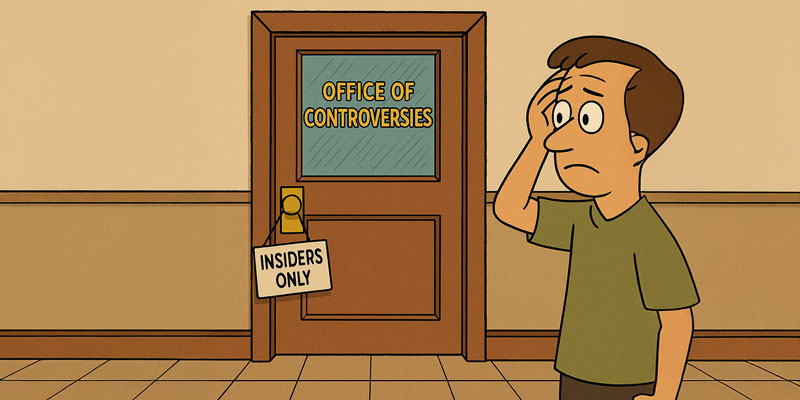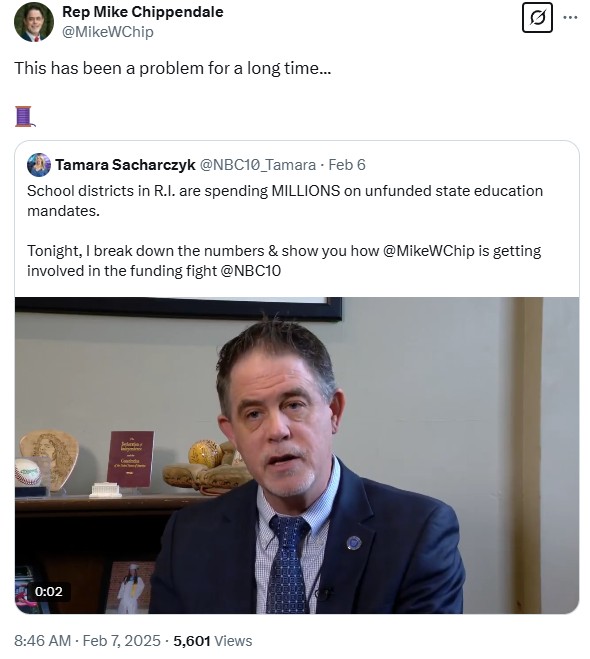On WNRI 1380 AM/95.1 FM, John DePetro and Justin Katz discuss:
- McKee: disapproved and unknown
- RIGOP disinterest in running for governor
- McNamara’s plea to be a colony, again
- Medicaid fraud at Eleanor Slater
- Naked teacher-union tests
- Foulkes fundraising
Featured image by Justin Katz using Dall-E 4o.
[Open full post]On WNRI 1380 AM/95.1 FM, John DePetro and Justin Katz discuss:
- Block v. Valicenti
- Hands Off the grift in RI
- Tariffs
- Grants in higher education
- Trump polling in RI
Featured image by Justin Katz using Dall-E 4o.
[Open full post]On WNRI 1380 AM/95.1 FM, John DePetro and Justin Katz discuss:
- The pastel-sweater Congressman and the over racist
- Magaziner admits he doesn’t plan to move
- Irresponsible elevation of a race-based school lawsuit
- What we might not know about the Washington Bridge grant
- An attempt to end the silence about schools’ interference with families
Featured image by Justin Katz using Dall-E 3 and Photoshop AI.
[Open full post]The Law Centre of the RI Center for Freedom and Prosperity has filed a complaint on behalf of a Rhode Island mother against a school district that guided her daughter toward “social transitioning,” hiding it from the mother along the way:
According to the complaint, “Unknown to Plaintiff, her daughter (as an 8th-grader) began to socially transition to a boy at school, with the help of school personnel.”
Because of RIDE’s guidance and polices, the complaint further states that “school personnel felt emboldened and compelled to encourage the daughter’s social transition, and to hide this fact from Plaintiff.”
Two years later, in the spring of 2024, as a 10th grader, the daughter attempted to commit suicide. Only then did the mother, Jane Doe, learn of her child’s multi-year transition …
The school district continues to keep secrets from Plaintiff, as it has subsequently refused to turn over the medical records of the daughter, a minor, despite an official release signed by her mother and legal guardian. A separate complaint was filed this past Friday with RIDE seeking the records that the daughter’s mother is legally entitled to.
The country is peppered with such stories. That doesn’t seem to be the case, though, because this isn’t a story journalists want to tell. They may, indeed, believe their role to be protecting the vulnerable and holding the powerful accountable, but they have a narrow and radical understanding of who falls on which side when it comes to progressive causes.
The school district and explicit state policy contributed of the estrangement of this daughter from her mother and a suicide attempt. This ought to be the stuff of media inquiry. And it ought to be the stuff of public outrage. Unfortunately, the public will not often find out about such events, and when people do catch wind of them, they internally discount the probability of the stories — perhaps assuming there must be more to them than is readily apparent — because they would have expected to receive the news from mainstream sources.
That isn’t how mainstream sources work, and as with the mass rape stories in the United Kingdom, we really must figure out how to repair this broken social nervous system.
[Open full post]On WNRI 1380 AM/95.1 FM, John DePetro and Justin Katz discuss:
- Patinkin’s radically moderate view on the Providence Council’s chief of staff
- Chippendale digs for information from behind the non-profit veil
- McKee’s cabinet gets raises
Featured image by Justin Katz using Dall-E 40.
[Open full post]On WNRI 1380 AM/95.1 FM, John DePetro and Justin Katz discuss:
- A Providence Council chief of staff we’re not allowed to find objectionable
- A Brown doctor whose foreign connections we’re not allowed to question
- Political insiders whose health we’re not allowed to worry about
- A housing compound we’re not allowed to view
Featured image by Justin Katz using Dall-E 40.
[Open full post]This effort from Republican State Representative Mike Chippendale is worthwhile:
Drawing attention to the mandates state and federal law impose on local school districts has the healthy effect of encouraging people to learn about education funding, generally, and rationalizing the budgets in this way should have broad electoral support.
BUT this entirely misses the fundamental point, as I understand it. The people who run local schools generally want the same things as the higher governments imposing the mandates. They especially like having a ready-made (while also vague) villain to blame for increasing spending and taxes.
In short, education mandates are part of the elaborate scam Rhode Island insiders run on us all. Unless Rep. Chippendale and his fellow Republicans intend to pivot toward exposing the scheme, then their plan is not fully formed.
[Open full post]On WNRI 1380 AM/95.1 FM, John DePetro and Justin Katz discuss:
- Whitehouse funds his wife with our money
- McKee knocks Hasbro, which forgets his phone number
- Foulkes commits to the Left
- GOP’s mixed response to the Providence Chamber
Featured image by Justin Katz using Dall-E 40.
[Open full post]









